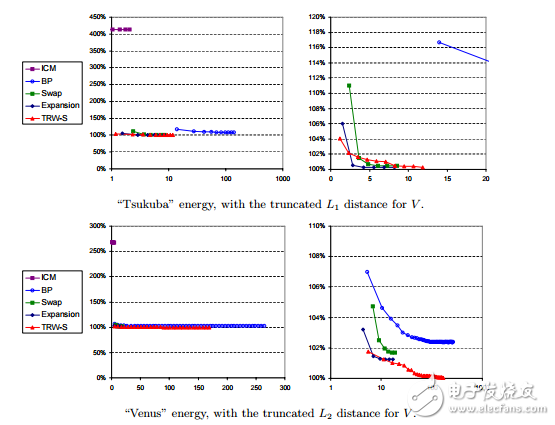資料介紹
1 Introduction Many problems in early vision involve assigning each pixel a label, where the labels represent some local quantity such as disparity. Such pixel labeling problems are naturally represented in terms of energy minimization, where the energy function has two terms: one term penalizes solutions that are inconsistent with the observed data, while the other term enforces some kind of spatial coherence. One of the reasons this framework is so popular is that it can be justified in terms of maximum a posteriori estimation of a Markov Random Field, as described in [1, 2]。 Despite the elegance and power of the energy minimization approach, its early adoption was slowed by computational considerations. The algorithms that were originally used, such as ICM [1] or simulated annealing [3, 4], proved to be extremely inefficient. In the last few years, energy minimization approaches have had a renaissance, primarily due to powerful new optimization algorithms such as graph cuts [5, 6] and Loopy Belief Propagation (LBP) [7, 8]。 The results, especially in stereo, have been dramatic; according to the widely-used Middlebury stereo benchmarks [9], almost all the top-performing stereo methods rely on graph cuts or LBP. Moreover, these methods give substantially more accurate results than were previously possible. Simultaneously, the range of applications of pixel labeling problems has also expanded dramatically, moving from early applications such as image restoration [1], texture modeling [10], image labeling [11], and stereo matching [4, 5], to applications such as interactive photo segmentation [12–14] and the automatic placement of seams in digital photomontages [15]。 Relatively little attention has been paid, however, to the relative performance of various optimization algorithms. Among the few exceptions is [16], which compared graph cuts and LBP, and [17], which compared several different max flow algorithms for graph cuts. While it is generally accepted that algorithms such as graph cuts are a huge improvement over older techniques such as simulated annealing, less is known about the efficiency vs. accuracy tradeoff amongst more recently developed algorithms. In this paper, we evaluate a number of different energy minimization algorithms for pixel labeling problems. We propose a number of benchmark problems for energy minimization and use these benchmarks to compare several different energy minimization methods. Since much of the work in energy minimization has been motivated by pixel labeling problems over 2D grids, we have restricted our attention to problems with this simple topology. (The extension of our work to more general topologies, such as 3D, is straightforward.) This paper is organized as follows. In section 2 we give a precise description of the energy functions that we consider, and present a simple but general software interface to describe such energy functions and to call an arbitrary energy minimization algorithm. In section 3 we describe the different energy minimization algorithms that we have implemented, and in section 4 we present our set of benchmarks. In section 5 we provide our experimental comparison of the different energy minimization methods. Finally, in section 6 we discuss the conclusions that can be drawn from our study.

- 基于隱馬爾科夫模型的公交乘客出行鏈識別 4次下載
- 融合灰色模型和馬爾科夫模型的農產品產量預測 7次下載
- 基于隱馬爾科夫模型的惡意域名檢測方法 6次下載
- 改進隱馬爾科夫模型的網絡態勢評估方法 5次下載
- 基于馬爾科夫鏈的隨機測量矩陣研究分析 7次下載
- 高精度近線性的馬爾可夫隨機場新模型iMRF 2次下載
- 一種融合馬爾科夫決策過程與信息熵的對話算法 6次下載
- 基于隱馬爾科夫模型和卷積神經網絡的圖像標注方法 4次下載
- 隨機過程的風速預測模型 8次下載
- 基于馬爾可夫隨機場模型的運動對象分割算法_王閃 0次下載
- 網絡系統的馬爾科夫時滯預測控制_黃玲 18次下載
- 基于非均勻馬爾可夫隨機場的圖像分割方法 0次下載
- 基于核密度估計和馬爾科夫隨機場的運動目標檢測 44次下載
- 基于簡化馬爾可夫隨機場的紅外圖像快速分割方法 25次下載
- 基于馬爾科夫鏈的網絡控制系統調度
- SystemVerilog的隨機約束方法 1821次閱讀
- FPGA的偽隨機數發生器學習介紹 1642次閱讀
- 什么是馬爾可夫建模,它的用途是什么? 1581次閱讀
- 命名實體識別實踐 - CRF 1413次閱讀
- 強化學習應用中對話系統的用戶模擬器 2048次閱讀
- 隱馬爾可夫模型描述一個含有隱含未知參數的馬爾可夫過程 4574次閱讀
- 基于模型的學習vs無模型學習 7179次閱讀
- 一文看懂AI制藥的作用 1.1w次閱讀
- 基于馬爾科夫的隨機場的圖像分割是一種基于統計的圖像分割算法 1.6w次閱讀
- 語音識別技術必定會滲透在人們生活的每個角落 8072次閱讀
- 隱馬爾科夫模型詳解分析 2099次閱讀
- 如何用隱馬爾可夫模型實現中文拼音輸入 8195次閱讀
- 哈夫曼算法的理解及原理分析,算法實現,構造哈夫曼樹的算法 3.4w次閱讀
- java實現的哈夫曼編碼與解碼 5782次閱讀
- 一種普適機器人系統同時定位、標定與建圖方法 3028次閱讀
下載排行
本周
- 1TC358743XBG評估板參考手冊
- 1.36 MB | 330次下載 | 免費
- 2開關電源基礎知識
- 5.73 MB | 11次下載 | 免費
- 3嵌入式linux-聊天程序設計
- 0.60 MB | 3次下載 | 免費
- 4DIY動手組裝LED電子顯示屏
- 0.98 MB | 3次下載 | 免費
- 5基于FPGA的C8051F單片機開發板設計
- 0.70 MB | 2次下載 | 免費
- 651單片機窗簾控制器仿真程序
- 1.93 MB | 2次下載 | 免費
- 751單片機大棚環境控制器仿真程序
- 1.10 MB | 2次下載 | 免費
- 8基于51單片機的RGB調色燈程序仿真
- 0.86 MB | 2次下載 | 免費
本月
- 1OrCAD10.5下載OrCAD10.5中文版軟件
- 0.00 MB | 234315次下載 | 免費
- 2555集成電路應用800例(新編版)
- 0.00 MB | 33566次下載 | 免費
- 3接口電路圖大全
- 未知 | 30323次下載 | 免費
- 4開關電源設計實例指南
- 未知 | 21549次下載 | 免費
- 5電氣工程師手冊免費下載(新編第二版pdf電子書)
- 0.00 MB | 15349次下載 | 免費
- 6數字電路基礎pdf(下載)
- 未知 | 13750次下載 | 免費
- 7電子制作實例集錦 下載
- 未知 | 8113次下載 | 免費
- 8《LED驅動電路設計》 溫德爾著
- 0.00 MB | 6656次下載 | 免費
總榜
- 1matlab軟件下載入口
- 未知 | 935054次下載 | 免費
- 2protel99se軟件下載(可英文版轉中文版)
- 78.1 MB | 537798次下載 | 免費
- 3MATLAB 7.1 下載 (含軟件介紹)
- 未知 | 420027次下載 | 免費
- 4OrCAD10.5下載OrCAD10.5中文版軟件
- 0.00 MB | 234315次下載 | 免費
- 5Altium DXP2002下載入口
- 未知 | 233046次下載 | 免費
- 6電路仿真軟件multisim 10.0免費下載
- 340992 | 191186次下載 | 免費
- 7十天學會AVR單片機與C語言視頻教程 下載
- 158M | 183279次下載 | 免費
- 8proe5.0野火版下載(中文版免費下載)
- 未知 | 138040次下載 | 免費
 電子發燒友App
電子發燒友App

















 創作
創作 發文章
發文章 發帖
發帖  提問
提問  發資料
發資料 發視頻
發視頻 上傳資料賺積分
上傳資料賺積分









評論